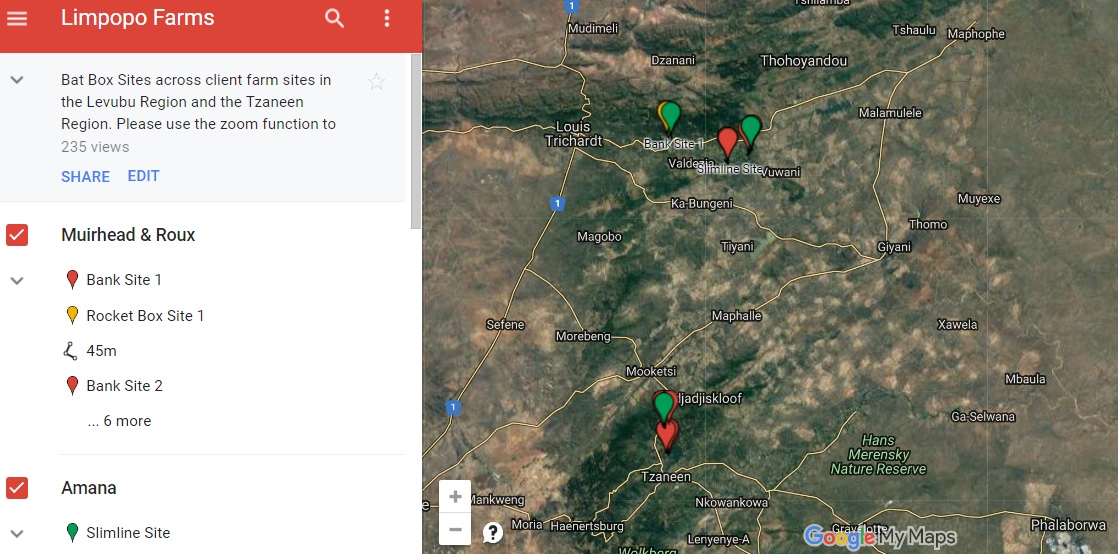Bats and Agricultural Pest Control
Primarily, bats reduce insect numbers in two ways. The first is direct predation, which roughly translates into how many insects a bat or a bat colony consume per night. The number of insects consumed by a bat varies considerably by species, season and reproductive cycle. It is estimated that a Little Brown Bat (Myotis lucifugus) in captivity consumes roughly 25% of its body weight in insects each night. Obviously, under natural conditions, this intake would increase as greater energy expenditure is required in the actual predation process. It is estimated that at a peak night of lactation, a 7,9g Little Brown Bat needs to consume 9.9g of insects- over 100% of its body weight (Kurta et al., 2010). This increase in consumption is a result of the costly energetic expenditures required during the reproductive cycle. At peak lactation, a female Brazilian Free-tailed Bat (Tadarida brasiliensis) can consume up to 70% of her body weight in insects each night. Like the Little Brown Bat, the Cape Serotine Bat (Neoromicia capensis) weighs between 6 - 10g. On average, our household mosquito weighs 2.5mg. There are 1000 milligrams to a gram (just a reminder). If we have an 8g bat exclusively eating 2.5mg mosquitoes nightly and requiring a conservative 65% of its body weight to sustain it, we come up with a mosquito consumption of 2080 mosquitoes per night. Simultaneously, this also disproves the “bat flying into your hair” theory. Requiring a nightly quota of 2000 mosquitoes, it’s not that they don’t want to fly into your hair, it’s just that they really don’t have the time.
Secondly, bats exert significant pressure on insect populations through behavioural trait mediation. Tympanic insects can detect the use of echolocation used by bats and consequently, will attempt to evade and avoid predation (Fenton & Fullard, 1979). Tympanic moths exhibit different responses to bat echolocation relating to both the distance from the bat and the frequency of the echolocation pulses (Roeder, 1964; Acharya & Fenton, 1992). Moths at a distance from the bat will often flee, while moths closer to the source may attempt to evade more imminent predation risk through employing irregular flight patterns, power dives or passive falls (Roeder, 1964). In addition to the response of various moths to the distance from the source of the echolocation pulse, an evasive response to the repetition rate of the pulse has also been recorded. The inference is that moths will respond to both the audibility of the pulse and the frequency of the pulse, thus enabling moths to determine bat "feeding buzz" and respond accordingly (Roeder, 1964). Predator avoidance behaviour is so acute in some pyralid and noctuid moths that they will abort sexually-orientated flight response to pheromone broadcasting females (Acharya and McNeil 1998). The predator avoidance behaviour recorded in moths is thought to be the major cause of the 50% reduction in damage by Corn Borer (Ostrinia nubilalis) when bat-like ultrasound pulses were broadcasted over corn farms in the US (Long & Hogan, 1998). The benefits of trait mediation may also extend to the suppression of herbivorous arthropods that may not be the selected dietary preference for insectivorous bats where aggregations of specific insect species are preferred (Preisser et al., 2005).
In addition to the increased insect consumption and the insect behaviour modification associated with higher bat populations in agriculture, the implementation of successful bat house programs may additionally lead to a reduction in the number of insecticide applications required annually. Aside from the cost benefits associated with reduced insecticide applications (Banaszkiewicz, 2010), it is held that the reduced number of applications will prolong the evolved resistance period by the target species to the insecticides active ingredient.
The incorporation of insectivorous bats into the management and control of herbivorous arthropods and the potential reduction of insecticide applications associated with this will lower the risk of insecticide residues reaching consumers and reduce the risk to human health.
Implementation:
Although the study of artificial roost site selection in insectivorous bats is ongoing, there are some things of which we are now reasonably certain. We know that location, orientation, type of box, environment and proximity to water are all important components in turning a bat house into an occupied bat house. A project undertaken by EcoSolutions in conjunction with the University of Venda and Subtrop, placed 100 bat houses within Macadamia nut orchards to assess the mitigation potential of bats on Stink bug populations. A year after installation, bat house occupancy has been recorded at all sites. EcoSolutions currently installs and manages bat house projects nationally. Through satellite imagery, we assist with the correct placement of bat banks on farms, the correct bat house designs ideally suited for potential bat occupancy and additionally, the installation, management and service of bat houses within these projects.
Artificial roost sites are used in various ways by different bat species, as well as by individuals of the same species. Bat houses may be used as maternity roosts, hibernacula, bachelor roosts and nocturnal “resting” roost sites. The requirement parameters between a maternity roost site and a "resting” site during a night of hunting, will differ. Bats are also known to move from one roost site to another as a consequence of predation pressure (the roost has been identified and is frequently visited by a predator of bats, i.e. a cat, or genet), by parasite pressure (increased mite and or lice numbers), or proximity to prey (bats will move to sites with higher insect numbers for consecutive nights in order to maximise feeding opportunity). It is for this reason, in conjunction with box design preference, that different box designs are incorporated into one bat bank.
The critical components:
EcoSolutions specialises, not only in the manufacture of bat houses but more importantly, maximising the potential occupancy of those houses. It would be fair to say that our unoccupied bat houses are just as important to us as our occupied ones. The success or failure of bat house design, placement, orientation, height, etc. provides us with the tools to build a bat house success blueprint. Bat houses and their use in an integrated pest management strategy is not a cottage industry, it is a science. Over the last 10 years, we have collected information designed to provide us and our clients with the most potentially viable bat house and integrated pest management programme. The key to this success depends primarily on the servicing and monitoring of our bat house programmes. During the bi-annual service we check for occupancy, we check bat house condition and replace or repair when necessary. We collect temperature data from data loggers, we collect guano for DNA marker analysis which provides us with information on both the bat species who utilise the bat houses as well as the prey species which they consume.
Where new information has provided us with greater insight into design, location or orientation of bat houses, we implement these improvements during the course of the bi-annual service. The service component is critical in order to facilitate occupancy and to ensure continued occupancy.
Bat boxes:

 In order to provide a selection of artificial roosts appealing to both bats of the same species as well as bats from different species, we use 3 fundamental designs. These are the Nursery box, the Six-Chamber box and the Old George box (an American design). The positioning of these 3 designs in parallel allows a greater range of roosting sites from which bats can choose.
In order to provide a selection of artificial roosts appealing to both bats of the same species as well as bats from different species, we use 3 fundamental designs. These are the Nursery box, the Six-Chamber box and the Old George box (an American design). The positioning of these 3 designs in parallel allows a greater range of roosting sites from which bats can choose.
It is always ideal to place 2 bat banks in 2 different locations within a site. As mentioned in the implementation paragraph above, this will allow bats to move between the 2 sites and this increases occupancy potential.
Once the environmental considerations have been addressed, the internal design of the bat box is the key to its success. The netted internal “fins” allow bats to obtain purchase when moving within this artificial roost site. The depth and height of the box allow bats to choose areas of the box that suit their ever changing temperature requirements. The landing pad beneath the box allows bats and pups to easily access the box and also allows bats to “light test” prior to emergence. It is important for the box to be well sealed and “calked’ which prevents light and water from entering the dark recesses of the box. All of our boxes are manufactured using recycled wood and are treated with Woodoc 55.
All our installed bat banks are recorded on Google maps and are regularly updated with occupancy and service information.
Please find an example of an interactive map below (Click to view the map).
To proceed to order directly, please click here


